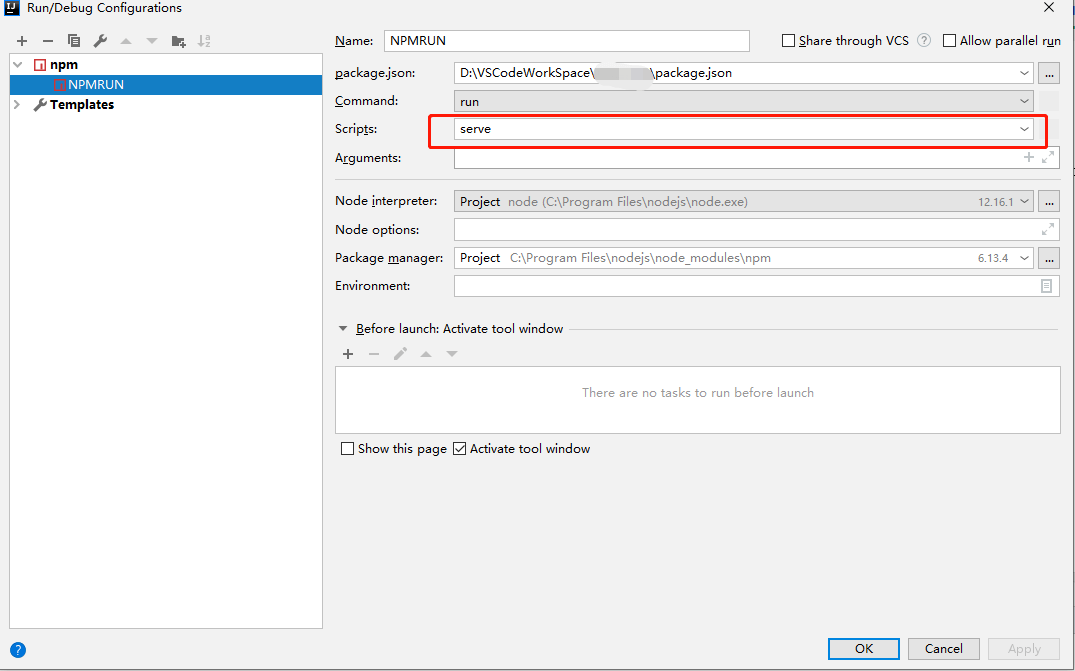SpringBoot+vue 前后端的分离项目笔记 [一] 项目搭建
最近学习研究springboot+vue项目,发现很好用,网上教程比较杂,所以写下这篇笔记,留作自用。
1、搭建环境
vue安装:(基本流程已忘,基本是按着这个来的)
教程:安装VUE教程 - 归尘2016 - 博客园
SpringBoot:环境搭建更早,基本只需要具备:java1.8
开发工具都是使用:IDEA
2、Vue项目创建
教程:Springboot Vue Login(从零开始实现Springboot+Vue登录)
这个教程我基本只参考了前半截,没添加element框架,也没有使用Springboot搭建不是用这个教程
创建完成之后用idea打开,配置好npm之后就可以直接启动vue:
教程:idea启动vue项目
如果是按上面教程创建项目,那用idea启动项目时有个地方要改:

3、SpringBoot项目创建
可以直接访问官方网站创建:start.spring.io
也可以用IDEA创建:快速创建springBoot项目
创建之后不要忘了改变端口:
application.properties
server.port=9090SpringBoot项目在IDEA可以直接启动
跨域访问问题在上面教程中有提到,可以参考:Springboot Vue Login(从零开始实现Springboot+Vue登录)
出现的问题:pom.xml中的jar包没加载出来,解决办法就是添加镜像
教程:maven国内镜像配置
4、Vue与SpringBoot简单交互(验正码)
在验证码方面,我主要是由后段生成图片与对应的码给前端,验证工作交给前端
Vue方面
1、axios配置
request.js
import axios from 'axios' //引入 axios
// 创建 axios 实例
const service = axios.create({
baseURL: 'http://192.168.1.129:9090/', // api 的 base_url
timeout: 15000, // 请求超时时间
});main.js
import axios from './utils/request';
Vue.prototype.$axios = axios;2、登录页
login.vue
<template>
<div class="page">
<form :model="loginForm" class="form form-horizontal" action="#/" method="post">
<input id="text" type="text" v-model="loginForm.username" placeholder="请输入账号" name="username">
<input id="pass" type="password" v-model="loginForm.password" placeholder="请输入密码" name="password" >
<label class="hq"><input id="text2" type="text" placeholder="请输入验证码" v-model="loginForm.inputCode" name="captcha">
<img class="rzm" :src='imgcode' @click="getIdentifyingCode(true)" >
</label>
<p class="submit">登录</p>
</form>
</div>
</template>
<script>
export default {
name: "login1",
data(){
return{
imgcode:'',
code:'',
loginForm:{
username:'',
password:'',
inputCode:'',
},
userToken:''
}
},
created:function() {
this.getIdentifyingCode();
},
methods:{
/*获取验证码*/
getIdentifyingCode: function () {
this.$axios.get('user/getImgCode')
.then((response) => {
this.imgcode = response.data.data;
this.code = response.data.imgCode;
// console.log(this.code)
})
.catch((error) => {
console.log(error);
});
}
}
}
</script>SpringBoot方面(教程忘记保存,直接贴上代码吧)
ImgValidateCodeUtil.java
import javax.imageio.ImageIO;
import java.awt.*;
import java.awt.image.BufferedImage;
import java.io.ByteArrayOutputStream;
import java.util.Base64;
import java.util.HashMap;
import java.util.Map;
import java.util.Random;
public class ImgValidateCodeUtil {
private static Random random = new Random();
/**
* 验证码的宽
*/
private static int width = 160;
/**
* 验证码的高
*/
private static int height = 40;
/**
* 验证码的干扰线数量
*/
private static int lineSize = 30;
/**
* 验证码词典
*/
private static String randomString = "0123456789abcdefghijklmnopqrstuvwxyz";
/**
* 获取字体
* @return
*/
private static Font getFont() {
return new Font("Times New Roman", Font.ROMAN_BASELINE, 40);
}
/**
* 获取颜色
* @param fc
* @param bc
* @return
*/
private static Color getRandomColor(int fc, int bc) {
fc = Math.min(fc, 255);
bc = Math.min(bc, 255);
int r = fc + random.nextInt(bc - fc - 16);
int g = fc + random.nextInt(bc - fc - 14);
int b = fc + random.nextInt(bc - fc - 12);
return new Color(r, g, b);
}
/**
* 绘制干扰线
* @param g
*/
private static void drawLine(Graphics g) {
int x = random.nextInt(width);
int y = random.nextInt(height);
int xl = random.nextInt(20);
int yl = random.nextInt(10);
g.drawLine(x, y, x + xl, y + yl);
}
/**
* 获取随机字符
* @param num
* @return
*/
private static String getRandomString(int num) {
num = num > 0 ? num : randomString.length();
return String.valueOf(randomString.charAt(random.nextInt(num)));
}
/**
* 绘制字符串
* @param g
* @param randomStr
* @param i
* @return
*/
private static String drawString(Graphics g, String randomStr, int i) {
g.setFont(getFont());
g.setColor(getRandomColor(108, 190));
String rand = getRandomString(random.nextInt(randomString.length()));
randomStr += rand;
g.translate(random.nextInt(3), random.nextInt(6));
g.drawString(rand, 40 * i + 10, 25);
return randomStr;
}
/**
* 生成随机图片,返回 base64 字符串
* @param
* @return
*/
public static Map<String, String> getImgCodeBaseCode(int length) {
Map<String, String> result = new HashMap<>();
// BufferedImage类是具有缓冲区的Image类,Image类是用于描述图像信息的类
BufferedImage image = new BufferedImage(width, height, BufferedImage.TYPE_INT_BGR);
Graphics g = image.getGraphics();
g.fillRect(0, 0, width, height);
// 获取颜色
g.setColor(getRandomColor(105, 189));
// 获取字体
g.setFont(getFont());
// 绘制干扰线
for (int i = 0; i < lineSize; i++) {
drawLine(g);
}
// 绘制随机字符
String randomCode = "";
for (int i = 0; i < length; i++) {
randomCode = drawString(g, randomCode, i);
}
// System.out.println("验证码是:" + randomCode);
g.dispose();
result.put("imgCode", randomCode);
String base64Code = "";
try {
//返回 base64
ByteArrayOutputStream bos = new ByteArrayOutputStream();
ImageIO.write(image, "PNG", bos);
byte[] bytes = bos.toByteArray();
Base64.Encoder encoder = Base64.getEncoder();
base64Code = encoder.encodeToString(bytes);
} catch (Exception e) {
e.printStackTrace();
}
result.put("data", "data:image/png;base64," + base64Code);
return result;
}
}LoginControll.java
@RestController
@SpringBootApplication
@RequestMapping("/user")
public class LoginControll {
//生成验证码
@RequestMapping(value = "/getImgCode")
@ResponseBody
public Map<String, String> getImgCode() {
Map<String, String> result = new HashMap<>();
try {
result = ImgValidateCodeUtil.getImgCodeBaseCode(4);
} catch (Exception e) {
System.out.println(e);
}
return result;
}
}结果:
![SpringBoot+vue 前后端的分离项目笔记 [一] 项目搭建](https://cdn.learnku.com/uploads/images/202005/15/60327/IM5i9DnNGV.png!large)
本作品采用《CC 协议》,转载必须注明作者和本文链接



 关于 LearnKu
关于 LearnKu




推荐文章: